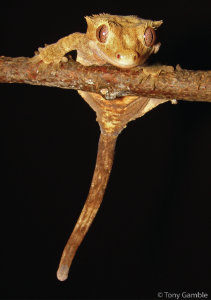Marquette study finds some gecko species have developed sticky tail pads
July 22, 2021
 MILWAUKEE — A new study led by a Marquette University graduate student finds that some species of geckos have sticky pads not just on their toes but have also developed adhesive pads on their tails that allow the lizards the strength to essentially use their tail as a fifth leg.
MILWAUKEE — A new study led by a Marquette University graduate student finds that some species of geckos have sticky pads not just on their toes but have also developed adhesive pads on their tails that allow the lizards the strength to essentially use their tail as a fifth leg.
The study published in the Proceedings of the Royal Society B was led by Aaron Griffing, a graduate student at Marquette pursuing his doctorate in evolutionary biology, with guidance from Dr. Tony Gamble, assistant professor of biological sciences in the university’s Klingler College of Arts and Sciences.
The study delves into the anatomy, sticky function and embryonic development of the toe and tail structures found in the New Caledonian crested gecko.
“Toe pads have fascinated naturalists for millennia, but very little attention has been paid to the tail pads of some geckos,” Griffing said. “We wanted to compare the structure of crested geckos’ adhesive tails with other sticky-tailed geckos, see just how (functionally) sticky they are, and determine if they develop in a similar pattern to sticky toes.”
Previous researchers hypothesized that gecko tail pads were serial homologs of toe pads — meaning that tail pads are duplicated structures, like the replicated legs that run the length of a centipede’s body. However, data from developing embryos, which is required to determine serial homology, has not been available until now.
Griffing’s team looked at hundreds of New Caledonian crested gecko embryos. The team discovered that the sticky tail pads of the geckos have a similar timing and pattern of development as their sticky toe pads, while the tail tips of a non-adhesive tailed gecko with toe pads did not exhibit these patterns.
Griffing said the findings suggest there is potentially a shared developmental program between sticky toes and tails.
“These findings provide an important foundation into understanding how adhesive structures grow in lizards,” Griffing said. “Further work, though, is needed to see whether similar genes are being expressed during the development of adhesive pads on the toes and tail.”
Additionally, Griffing’s study found that the sticky tail pads of crested geckos can support up to five times the mass of the lizard itself, which exceeds the adhesive strength of the entire hand in some other lizard species. Moreover, the tail pad generates about as much force as a single crested gecko toe.
The study included contributions from scientists from Loyola University Chicago, Villanova University, the University of California, Riverside, the Milwaukee Public Museum and the Bell Museum of Natural History.
The study was funded by the National Science Foundation, Loyola University Chicago and the Villanova University Gerald M. Lemole Endowed Chair Fund.
About Shelby Williamson
Shelby is a senior communication specialist in the Office of Marketing and Communication. Contact Shelby at (414) 288-6712 or shelby.williamson@marquette.edu
 MILWAUKEE — A new study led by a Marquette University graduate student finds that some species of geckos have sticky pads not just on their toes but have also developed adhesive pads on their tails that allow the lizards the strength to essentially use their tail as a fifth leg.
MILWAUKEE — A new study led by a Marquette University graduate student finds that some species of geckos have sticky pads not just on their toes but have also developed adhesive pads on their tails that allow the lizards the strength to essentially use their tail as a fifth leg.